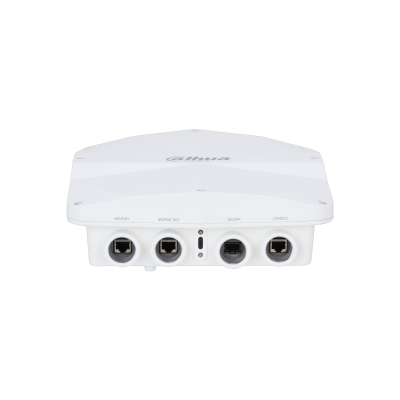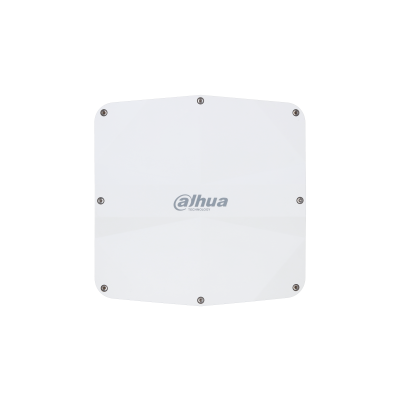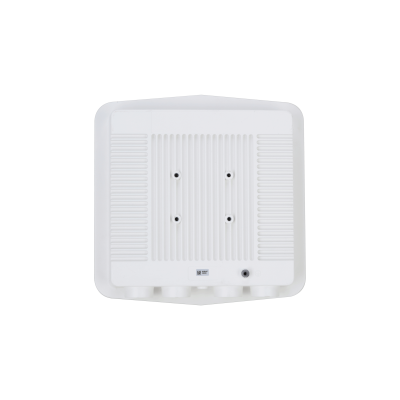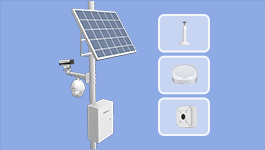AWA6220-O
802.11ax Outdoor Wireless Access Point
> 802.11ax Outdoor Wireless Access Point.
> Internal Antennas 4 Streams Dual Radio and support External Antennas.
> Up to 1.775 Gbps access rate.
> Gigabit SFP optical port.
> IP68 waterproof and dustproof design.
> –30 °C to +55 °C wide temperature.
> Support DL/UL MU-MIMO and OFDMA.
> Maximum transmit power up to 24 dBm.
> Antenna gain up to 5 dBi.

Hardware
Weight (excluding mounting accessories)
1.8 kg (3.97 lb)
Dimensions (excluding mounting and accessories)
250 mm x 250 mm x 79.5 mm (9.84" × 9.84" × 3.13") (L × W × H)
Ethernet Ports
2 × 100M/1000M Base-T RJ-45
1 × 100M/1000M Base-X SFP
1 × Console port (RJ-45)
Antenna
Internal directional antenna, antenna gain: 11 dBi@2.4G/11 dBi@5G/ Horizontal beamwidth (HBW): 65 degrees
Vertical beamwidth (VBW): 30 degrees
Support extended external antenna
Working Frequencies
802.11ax/ac/n/a: 5.725 GHz–5.850 GHz; 5.47 GHz–5.725 GHz; 5.15 GHz–5.35 GHz
802.11ax/b/g/n: 2.4 GHz–2.483 GHz
Modulation Mode
11b: DSS: CCK@5.5/11 Mbps, DQPSK@2 Mbps, DBPSK@1 Mbps
11a/g: OFDM: 64QAM@48/54 Mbps, 16QAM@24 Mbps, QPSK@12/18 Mbps, BPSK@6/9 Mbps
11n: MIMO-OFDM: BPSK, QPSK, 16QAM, 64QAM
11ac: MIMO-OFDM: BPSK, QPSK, 16QAM, 64QAM, 256QAM
11ax: MIMO-OFDM: BPSK, QPSK, 16QAM, 64QAM, 256QAM, 1024QAM
Maximum Transmit Power
2.4 GHz: 27 dBm
5 GHz: 24 dBm
Reset/Restoration To Factory Default
Yes
State LED
Alternating flashing mode, orange/green/blue for different working states, breathing mode
Enviorment
Outdoor
Working Temperature
––30 °C to 55 °C (–22 °F to 131 °F )
Storage Temperature
–40 °C to 70 °C (–40 °F to 158 °F )
Working Humidity
0%–100% (non-condensing)
Storage Humidity
0%–100% (non-condensing)
Protection Class
IP68
EMC
CE EMC, CE RED
MTBF
>500000H
Software specifications
Compliance
Compliant with 802.11a/b/g/n/ac/ax
Working Frequencies And MIMO
5 GHz 2 × 2: 2 MU-MIMO 1.2 Gbps
2.4 GHz, 2 × 2: 2 MU-MIMO 0.575 Gbps or
5 GHz (1) 2 × 2: 2 MU-MIMO 1.2 Gbps
5 GHz (2) 2 × 2: 2 MU-MIMO 1.2 Gbps dual 5G mode
Bandwidth
20 MHz/40 MHz/80 MHz
WLAN Basics
Maximum number of clients per radio: 512
Virtual APs: 32
Open system/shared key authentication
Broadcast probe request acknowledge control
Mixed connection for WPA, WPA2, WPA3 and Pre-RSNA users
RTS/CTS
CTS-to-self
802.11k and 802.11v smart roaming
802.11r fast transition roaming
Advanced Traffic Management
Restrict low rate/sticky terminals access
Channel reuse
Receiver sensitivity adjustment
Automatic channel/power/bandwidth adjustment
Hide SSID
Hotspot 2.0
Security Policy
WEP-64/128/152bit, dynamicWEP, TKIP, AES, EAP, CCMP, WPA3, OWE
Multiple encryption key triggered dynamic unicast/multicast key update
Support 802.11i
802.1X authentication, MAC authentication, PSK authentication, Portal authentication, PPSK
Layer 2 user isolation
SSID-based user isolation
Packet filtering
MAC address filtering
Broadcast storm suppression
Wireless EAD
SSID and VLAN binding
WIDS/WIPS
Rogue device detection and countermeasure
Dynamic ARP Inspection
IP Source Guard (IPSG)
Management frame protection (802.11w)
AAA
RADIUS client
Multiple-domain authentication server
Backup authentication server
Layer 2 And Layer 3 Features
IP address configuration :Static IP (available only in fat AP mode)/DHCP assigned IP (Option 60)
IPV6: Native IPv6/IPv6 Portal/IPv6 SAVI
ACL: IPv4/IPv6
Local forwarding based on SSID and VLAN
Link Layer Discovery Protocol (LLDP)
SSID-based VLAN assignment
EoGRE Tunnel
Multicast:IGMP Snooping/MLD Snooping
QoS
802.11e :Wi-Fi Multimedia (WMM)
802.1p priority and marking on Ethernet ports
Priority mapping for wired and wireless connection
SSID/VLAN and QoS policy mapping
Layer 2 to Layer 4 packet filtering and traffic classification
CAR
User bandwidth management
Load balancing
Multicast enhancement:Multicast to Unicast (IPv4, IPv6)
Call Admission Control (CAC)
Airtime optimization
Airtime fairness
Layer 4-7 application identification
SVP Phone
Management and Maintenance
AP Working Mode : Fit/Fat
Network management:Trap, HTTP(S), SSH, Telnet, FTP/TFTP, SNMP V1/V2/V3 only applicable in Fat mode
Management SSID
Syslog
Remote probe analysis

















